#epinephrine auto-injector
Explore tagged Tumblr posts
Text
Daily writing promptCreate an emergency preparedness plan.View all responses My entire life is a perpetual emergency preparedness plan. Image taken from Internet Living with life-threatening allergies to most medicines and foods, and many chemicals, has instilled in me a state of vigilance that most people reserve for catastrophic events. Every outing, every meal, every interaction with the…

View On WordPress
#adrenaline auto-injector#allergy#Bug-Out Bag#dailyprompt#dailyprompt-2030#disaster#Emergency#emergency plan#epinephrine auto-injector#first-aid kit#food#Grit#medication#medicines#Planning#preparedness#preparedness plan#Raffaello Palandri#resilience#Training
0 notes
Text
Anaphylactic Shock: Understanding and Reacting to a Life-Threatening Emergency
Learn to recognize and respond to anaphylactic shock with this comprehensive guide. Discover causes, symptoms, and emergency steps, including using an epinephrine auto-injector. Be prepared to save lives with essential insights on managing severe allergic

View On WordPress
#allergic reaction treatment#allergy emergency response#anaphylactic reaction#anaphylactic shock#anaphylactic shock emergency#anaphylactic shock management#anaphylactic shock treatment#anaphylaxis#anaphylaxis first aid#anaphylaxis medical care#anaphylaxis prevention#anaphylaxis response steps#anaphylaxis symptoms#causes of anaphylaxis#epinephrine auto-injector#how to treat anaphylactic shock#how to use epinephrine injector#recognizing anaphylaxis#severe allergic reaction#what to do during anaphylaxis
0 notes
Text
Recognizing the Signs of Severe Allergic Reactions and How to Respond
Allergic reactions are a part of life for millions of people, but not all reactions are the same. While mild symptoms like sneezing or skin rashes are manageable, severe allergic reactions — known as anaphylaxis — can be life-threatening if not treated immediately. Recognizing the warning signs and knowing how to respond can mean the difference between a safe recovery and a dangerous emergency.
What Is a Severe Allergic Reaction?
A severe allergic reaction occurs when the body’s immune system overreacts to a harmless substance, like food, insect stings, medications, or environmental triggers. This overreaction releases chemicals that can cause a sudden drop in blood pressure, difficulty breathing, swelling of the throat and tongue, or even unconsciousness. Without fast intervention, anaphylaxis can quickly become fatal.

Common Triggers of Severe Allergic Reactions
Some of the most frequent causes include:
Peanuts, tree nuts, shellfish, and dairy
Bee or wasp stings
Prescription medications like penicillin
Latex and other environmental allergens
Since anaphylaxis can develop within minutes of exposure, having an emergency action plan in place is crucial for those at risk.
How to Respond During an Emergency
When someone begins experiencing symptoms of a severe allergic reaction, immediate action is essential:
Administer epinephrine immediately. It’s the only first-line treatment proven to stop anaphylaxis.
Call emergency services and inform them of the reaction.
Monitor the person’s breathing and keep them lying down with their legs elevated, unless breathing becomes difficult.
Nasdepi: A Modern Solution for Fast, Needle-Free Relief
Traditional epinephrine auto-injectors have long been the standard, but not everyone feels comfortable using them, especially during high-stress moments. That’s where Nasdepi, developed by Belhaven Biopharma, offers a breakthrough. It’s a nasal spray epinephrine option designed for quick, easy use without the fear of needles — ideal for schools, families, and public events.
This innovative option ensures fast medication delivery while offering peace of mind for those with needle phobia or limited medical training.
To learn more about how Nasdepi is changing the way severe allergic reactions are treated, visit Belhaven Biopharma’s Nasdepi page for complete details.
#Belhaven Biopharma#Severe Allergic Reactions#Needle Phobia#Nasdepi#allergy symptoms#epinephrine auto-injectors#anaphylaxis
0 notes
Text
A Decade of Change: Epinephrine Auto-Injectors Market Outlook from 2024 to 2034
The global epinephrine auto-injectors market is witnessing significant growth, fueled by an alarming rise in allergy prevalence and the urgent need for life-saving treatment options. According to recent market analysis, global sales of epinephrine auto-injectors are estimated at USD 2,228.0 million in 2024 and projected to reach USD 3,394.4 million by 2034, growing at a CAGR of 4.3% during the forecast period.
In 2023, the market generated USD 2,136.2 million, reflecting strong year-on-year growth and increasing global demand. This surge is largely driven by the increasing incidence of anaphylaxis, particularly related to food allergens, drug reactions, and insect stings, with children being especially vulnerable.
Explore Market Dynamics: Request Your Sample Report Now! https://www.futuremarketinsights.com/report-sample#5245502d47422d3134383736
Rising Allergy Burden Fuels Demand for Epinephrine Auto-Injectors
The sharp increase in food allergies, especially from peanuts, shellfish, and tree nuts, is contributing to the rising global need for epinephrine auto-injectors. Anaphylaxis—a severe, potentially life-threatening allergic reaction—requires immediate treatment, and epinephrine auto-injectors are widely recognized as the most effective solution.
Alongside food-related triggers, insect stings and reactions to antibiotics and NSAIDs like aspirin are leading causes of anaphylactic emergencies. This has resulted in more medical professionals recommending patients to carry auto-injectors as a precaution, driving consistent market demand.
Technological Innovation Enhances Accessibility and Usability
Manufacturers are pushing the boundaries of innovation, making devices that are easier to use, even for those with no medical training. Voice prompts, clearer instructions, compact form factors, and intuitive design have made epinephrine auto-injectors more user-friendly—ensuring that both patients and bystanders can confidently administer a dose during an emergency.
These innovations are not just enhancing patient compliance and safety but also expanding the adoption of the product across a wider demographic, including school-aged children and the elderly.
Market Access and Affordability Drive Global Expansion
The increasing availability of generic epinephrine auto-injectors is another significant growth driver. Competitive pricing has brought the devices within reach for a broader population, especially in low- and middle-income countries. Additionally, supportive government initiatives and insurance coverage are improving access to life-saving epinephrine devices in key markets.
The rising exposure to environmental pollutants and new allergens—largely attributed to climate change and urbanization—is leading to a growing number of people developing allergic sensitivities. Consequently, the global health ecosystem is pushing for wider access to emergency treatment, further fueling demand for epinephrine auto-injectors.
Key Takeaways
India and China are expected to witness the fastest growth in market value, with CAGRs of 4.9% and 4.3% respectively from 2024 to 2034.
The USA and Germany are projected to grow at a modest CAGR of 1.3% over the same period.
The 0.3 mg dosage segment dominates the market with a 46.6% value share in 2024.
By age group, children aged 5–14 years represent the largest consumer base, accounting for a 23.5% market share in 2024.
Soaring Demand for Market Information: Uncover Detailed Trends and Insights in Our Report! https://www.futuremarketinsights.com/reports/epinephrine-auto-injectors-market
Competitive Landscape: Key Players and Strategic Movements
The epinephrine auto-injectors market is highly competitive, with companies adopting strategic collaborations, product innovation, and global expansion tactics to gain a competitive edge.
Leading manufacturers are focusing on product differentiation, not only through dosage options but also through advanced delivery systems and patient-centric features. Another key strategic direction involves forming partnerships with hospitals, clinics, and healthcare providers to streamline distribution and improve reach.
Key Market Players:
Adamis Pharmaceuticals Corporation
ALK-Abello A/S
Impax Laboratories, Inc.
Viatris
Antares Pharma
Recent Industry Developments:
Viatris continues to dominate the market with its flagship EpiPen brand. In 2023, the company took major steps to enhance affordability and access, particularly in response to growing demand for generics.
ALK Abello, with its Jext auto-injector, is investing in clinical trials to demonstrate competitive efficacy and safety. The company is expected to launch a next-generation product in 2024 featuring enhanced safety features.
Key Segments of Epinephrine Auto-Injectors Market
By Dosage:
In terms of dosage, the industry is segregated into 0.15 mg, 0.3 mg and others.
By Age Group:
In terms of age group, the industry is divided into 0-4 years, 5-14 years, 15-24 years, 25-49 years, 50-64 years and above 65 years.
By End User:
In terms of end user, the industry is divided into hospitals, clinics, home based and others.
By Region:
Key countries of North America, Latin America, Western Europe, Eastern Europe, South Asia & Pacific, East Asia and Middle East and Africa (MEA) have been covered in the report.
Outlook
The epinephrine auto-injectors market is poised for robust growth over the next decade. Factors such as rising allergy prevalence, increased awareness of anaphylaxis, technological advancements, and expanding healthcare coverage are converging to create a favorable environment for manufacturers and stakeholders.
As allergies continue to affect people across all age groups and geographies, the importance of timely treatment with auto-injectors cannot be overstated. With governments, healthcare providers, and manufacturers working in tandem, the market is expected to see consistent growth and broader patient reach in the years to come.
0 notes
Text
Writing Notes: Food Allergies

Food allergies - the body’s abnormal response to specific proteins found in food. These proteins normally are harmless but cause a reaction in some people. They can occur when food is either eaten or touched.
Many people use the term ‘‘food allergy’’ to describe what is actually a food intolerance.
A food intolerance is a reaction to food that does not involve the immune system.
Lactose intolerance is a common food intolerance, while celiac disease is a food allergy.
Eight foods cause 90% of all food allergies. These are:
milk
eggs
peanuts
tree nuts (walnuts, cashews, pecans, almonds, etc.)
fish
shellfish
soy
wheat
When the body encounters an allergen, it releases large amounts of histamine.
The release of this chemical is responsible for allergic symptoms.
Symptoms of food allergy can range from mildly annoying to dangerous and life threatening.
These symptoms include:
tingling of the mouth
tingling or numbness in arms or legs
skin rash or hives
itching
abdominal cramps
vomiting
diarrhea
breathing difficulties
sudden drop in blood pressure (hypotension)
swelling of the tongue
swelling of the face and throat
loss of consciousness
death
The most serious symptom of food allergy is anaphylaxis.
Anaphylaxis, also called anaphylactic shock, is a sudden and potentially life threatening allergic reaction in which the whole body reacts to an allergen.
During anaphylaxis, the airway constricts, making breathing difficult.
Swelling of the throat may block airways as well.
Vomiting and diarrhea may occur.
The face may swell and the skin may become itchy with a rash or hives.
The heart may race and the heartbeat may become irregular.
Treatment for an allergic reaction is administration of an antihistamine drug.
The most common antihistamine is diphenhydramine hydrochloride; found in over-the-counter drugs, such as Benadryl, and in some prescription drugs.
If taken immediately, antihistamines can stop or moderate an allergic reaction.
In cases of a severe allergy or anaphylaxis:
an injection of a strong antihistamine called epinephrine (also known as adrenaline) may be used.
An auto-injectable form of epinephrine (Epi-Pen) that looks similar to a large ballpoint pen can be carried at all times if a person has a history of severe allergy.
If a severe allergic reaction occurs, the auto-injector is held against the skin and the medication is self-administered as a shot.
Epinephrine is a strong antihistamine; it often can stop anaphylaxis symptoms.
Source ⚜ More: Notes & References ⚜ Writing Realistic Injuries ⚜ On Allergy
#writing reference#writeblr#dark academia#spilled ink#writers on tumblr#literature#writing inspiration#writing notes#writing prompt#poets on tumblr#writing ideas#creative writing#fiction#medicine#food#allergy#pierre-auguste renoir#writing resources
89 notes
·
View notes
Note
hi! a friend of mine has recently told me a bunch of stuff about how i could include some disabled characters in my short stories (i write hurt/comfort for the record) and what they'd like to see more of.
something on the list was "[disabled people] have access to certain medical supplies that normally wouldn't be accessible." google isn't being super helpful as it's a pretty vague statement. can you give me some examples of this? would it be syringes and needles? or certain medication that's easy to use with malicious intent? (also for the record, they were specifically asking if i could write more disabled characters doing the hurting instead of being victims of it, since that tends to be an underrepresented category). i dont even know where to start researching since there's so many types of disabilities, so any help would be hugely appreciated!
Hello,
Prescriptions open up a world of medical supplies that the public would have to jump through major hoops to access or wouldn't be able to access at all. For example, epinephrine auto-injectors, commonly known as Epi-Pens. In America, one can only get those with a prescription or if you're the caretaker for someone who has life-threatening allergies, there is no other way to get them unless you buy them from a shady sight from the United Kingdom or Canada. Even Adrenaclic, created by CVS Pharmacy, which also treats anaphylaxis, is only available when prescribed by a medical professional. Disabled people with chronic pain can access medical marijuana, or even medical-grade opioids. One can't legally buy Schedule 2 Drugs (things like Adderall) without a prescription. It'll depend on what condition they have, but prescription medications are a huge part of that "access to supplies the rest of the population can't have."
The second thing is medical-grade sterile equipment. Sure, you can buy IV bags off of Amazon for fifteen dollars for fifty, but those probably aren't medical-grade and you don't have a guarantee that they're good or safe quality. IV fluids are hard to find at a reasonable price. Syringes? Those absolutely need to be sterile, it's not safe to buy those from anywhere that isn't a pharmacy. All of this stuff is best purchased as medical-grade, meaning it could be used by a doctor or a hospital, and they aren't buying this stuff from Amazon. Pharmacies get this stuff from similar, maybe even the same, sources as hospitals are getting them, and a pharmacy will probably only sell you most of this stuff to someone who's prescribed it and who has a diagnosed medical condition that requires it. Even then, disabled people usually need to jump through hoops to get our medical equipment.
And the third is something that might surprise you- mobility and assistance devices. Yes, you can get a cane from Walmart or a hospital-type wheelchair from Target, but those aren't personalized. They'll do the job but an abled person probably can't get a custom-built wheelchair as easily as someone with cerebral palsy can. This isn't saying it's easy for disabled people to get these things, it's just easier than it is for the general population. Plus, things such as a class three powerchair are thousands of dollars. If you're prescribed one, insurance might cover part of it, or you might have the option to receive these things for free from charities, or at a discounted rate, especially if you're low-income. You can buy them if you're abled, sure, but you'll have access to a better way to go about it if you're actually disabled.
Again, nothing on this list is guaranteed to be a breeze for a disabled person, but there are routes we can take that make getting them easier than it would be for an abled person who doesn't need them.
Mod Aaron
36 notes
·
View notes
Note
/* does not have to be a thread, or a long one, but this has been in my head for a while... thinking it takes place a maybe a month or so after our current thread
--@not-that-dillinger*/
Ed sat across from Tron, his back perfectly straight, though it still took what felt like a herculean effort to look his oldest brother in the face. He could feel the galloping pace of his heartbeat in his throat as he hesitantly set the auto-injector on the table between them. It looked much like the one he usually carried with him: a fat white tube with a blue safety cap on one end and orange plastic tip on the other. Except rather than the yellow instructions label, the label on this one was white, and had in bold letters TRAINER. FOR PRACTICE ONLY on the top. It almost looked like an oversized toy of a ballpoint pen.
"I've been thinking about what you said," Ed started. "About... finding someone I trust to... administer the epinephrine in an emergency."
As much as Ed would rather just avoid the topic entirely and not think about it, the monitor did have a point. And while being near Tron still made Ed anxious, he did trust him, and that was sort of the point. If Ed could talk Tron through how to use the auto-injector, then maybe he could do the same with Alan without feeling so anxious about it. And if he could have that conversation with Alan, then surely talking anyone else through it wouldn't seem like such a monumental task.
"This one's meant for practice," he explained. "No needle or medicine, but the mechanism's the same."
Tron hadn't been sure what to expect when Ed had asked him to drop by after work hours were over. Something new for the Grid, perhaps, or a new plan of attack when it came to ensuring what was left of the dangerous arm of fCom couldn't do anything while Alan finished up negotiating buying out the assets and taking onboard as many of the staff as he could get away with.
Not this.
Surely Ed trusted Yori or Eve more, would have instructed them first.
But Yori still wasn't sure, although she knew Ed's extensive list of allergies by now and could keep them away from any food brought to the Grid. And Eve probably knew more in theory than most nurses, the amount of research she'd gotten her hands on, but hadn't learned the practical yet.
Beck probably knew how to use one, busy taking multiple first aid courses so he could help in any crisis. Some were focused on the potential disasters that could happen in a workshop or garage, but... not all. Always looking for new ways to help, that beta.
Inspecting the pen meant Ed didn't have to struggle with eye contact. Trainer?
Ah. A practical simulation, no real stakes if Tron didn't get it right first try. That made sense.
"I'm honoured you trust me with this." Tron told Ed quietly. "Thank you."
#maybe not a long thread - just a few scenes?#foreshadowing the ideas we had re:julian in the other thread - beck will know how to use an epipen by the time he needs to use one for ed...#but he doesn't have to learn that onscreen as such
7 notes
·
View notes
Note
great allergy post btw!!
I think its easy to say good allergies aren’t that bad because they’re avoidable and the symptoms aren’t really chronic in the same sense that typical disabilities are. But my god the social effects! Having to bring your own food everywhere and be mindful about traveling and plane rides constantly is really draining after a while, especially with very common allergens like gluten or meat or egg. Like it’s crazy to me that most people can just eat whatever (like random food trucks in particular because damn I wish) because I’ve never gotten to do that
also the comorbidities! asthma alone accounts for a long term impact of allergen exposure.
people do not care to understand the severity of anaphylaxis and I've even been in first aid trainings where all they did was pass the Epi-Pen trainer around. a certain popular public charter [R.E.D.A.C.T.E.D] doesn't even mandate allergy certification through the first aid/cpr provider they choose. (a majority of first aid/cpr courses I've taken are phenomenal with allergy training fwiw)
ANYWAYS here are the signs and symptoms of anaphylaxis and what to do if you or someone is experiencing them!
If you or someone you know is experiencing anaphylaxis, call emergency services immediately. Do not delay care. If you're unsure, call anyways. Symptoms can be rapid or within 2 hours of exposure.
Do not delay care after administering epinephrine (Epi-Pen, Adrenaclick, Auvi-Q, etc), it is only temporary, hospital care is necessary.
Do not assume that someone with an allergy has an epinephrine injector, especially in places where you have to pay for healthcare.
If someone goes unresponsive and is not breathing during an allergic reaction, start CPR (adult | child+infant) immediately.

Image description: an infographic from the Food Allergy & Anaphylaxis Connection Team titled "SIGNS AND SYMPTOMS OF ANAPHYLAXIS"
Anaphylaxis (an-a-fi-LAK-sis) is a serious allergic reaction that comes on quickly and has the potential to become life-threatening. The most common anaphylactic reactions are to foods, venom, medications, and latex. Anaphylaxis signs and symptoms that may occur alone or in any combination after exposure to an allergen include:
MOUTH: itching, tingling, swelling of the lips/tongue/palate (roof of the mouth)
THROAT: hoarseness, tightening of throat, difficulty swallowing, hacking cough, stridor (a loud, high-pitched sound when breathing in)
LUNGS: shortness of breath, wheezing, coughing, chest pain, tightness
GUT: abdominal pain, nausea, vomiting, diarrhea
CNS/BRAIN: anxiety, panic, sense of doom
EYES/NOSE: runny nose, stuffy nose, sneezing, watery red eyes, itchy eyes, swollen eyes SKIN: hives or other rash, redness/flushing, itching, swelling
CIRCULATION/HEART: chest pain, low blood pressure, weak pulse, shock, pale blue color, dizziness or fainting, lethargy (lack of energy)
Symptoms involving the throat, lungs, and circulation/heart are marked with asterisks, indicating immediate and potential life-threatening symptoms.
Consult with a board-certified allergist for an accurate diagnosis and management plan.
Although the majority of individuals experiencing anaphylaxis have skin symptoms, some of the most severe cases have no rash, hives, swelling
EPINEPHRINE is the first-line of treatment for anaphylaxis Antihistamines, inhalers, & other treatments should only be used as secondary treatment. Always carry two epinephrine auto-injectors at all times.
When you, or someone you know, begin to experience symptoms, CALL 9-1-1 IMMEDIATELY!
FAACT Food Allergy & Anaphylaxis Connection Team
AWARENESS • ADVOCACY • EDUCATION www.FoodAllergyAwareness.org
(513) 342-1293 Fax (513) 342-1239
P.O. Box 511 West Chester, OH 45071 [email protected]
[end ID]
106 notes
·
View notes
Note
Why is it that anyone can easily by Narcan, no prescription needed, just in case someone overdoses, but people who don't have allergies aren't allowed to be Epinephrine auto-injectors (Epi Pens) in case someone goes into anaphylaxis but doesn't have one? They're both life-saving, so why is Narcan no strings attached but Epi Pens are basically illegal to own without a prescription? I'm being genuine as someone who works in food service
-
18 notes
·
View notes
Text
My Lifesaver: The Adrenaline Auto-injector
Daily writing promptWhat is the most important thing to carry with you all the time?View all responses For most people, the most important thing that they carry all the time is probably their phone, wallet, or keys. But for me, my adrenaline auto-injector is far more crucial. Image found on Internet Living with multiple life-threatening allergies means constantly being aware of potential…

View On WordPress
#adrenaline#adrenaline auto-injector#allergic reaction#allergy#anaphylaxis#dailyprompt#dailyprompt-2025#epinephrine#epinephrine auto-injector#hormone#independence#preparedness#Raffaello Palandri#responsibility
0 notes
Text






























International Red Sneakers Day
Not everyone knows that allergies can be life-threatening, so education on the fatality of allergies is one of the aims of International Red Sneakers Day, which is observed on May 20. The non-profit organization Red Sneakers for Oakley invites the entire world to join and requests that everyone wear their red shoes to draw attention to the rising food allergy problem, which affects around 250 million people around the world. Today provides an opportunity to use a straightforward but powerful symbol like red sneakers as a means of drawing attention to the severity of the challenges that people with food allergies face all around the world. The event also serves as a platform to raise awareness about the dangers associated with food allergies.
History of International Red Sneakers Day
On Thanksgiving Day in 2016, the Debbs family traveled to Maine with all of their extended family to celebrate the holiday. Because it was freezing outside, aside from spending most of the day participating in sports, Oakley Debbs also spent around two hours at a fun park bouncing on trampolines. After everyone went to eat dinner. Oakley did not eat his meal because he said it was too spicy.
Oakley returned home and ate a cake that included either nut extract or nuts without realizing it, resulting in a fatal allergic reaction. The unfortunate outcome was that he passed away, and his family felt that they were not adequately informed about the danger of allergic responses, which ultimately resulted in his death. In their opinion, Oakley’s allergist’s office did not provide them with sufficient information about the hazards of food allergies. In their ignorance, they did not realize that antihistamines (such as Benadryl) do not alleviate systemic symptoms and that epinephrine is the only first-line treatment for anaphylaxis. After that, they realized they needed to do something to stop this from happening to anyone else in the same situation. So to create public awareness and in memory of their son, they established the non-profit organization Red Sneakers for Oakley. It was only natural for Oakley’s parents to use his favorite shoes as a powerful symbol to convey the severity of his food allergies, given that he wore red sneakers in all of the sports that he participated in.
With the belief that education is needed between allergists, hospitals, first responders, parents, school personnel, and the general public at its core, the nonprofit organization’s mission is to raise awareness of food allergies around the world, and they have committed their resources to education and activism.
International Red Sneakers Day timeline
1910 Histamines
Sir Henry Hallett Dale makes the first discovery of histamines as a contaminant of ergot, which is produced by bacterial action.
1937 The Antihistamine Chemical
The first antihistamine chemical is identified by Daniel Bovet and found to be beneficial in treating allergic reactions because it counteracts the effect of histamines.
1944 Pyrilamine
Bovet’s invention, Pyrilamine, is made into a medication.
1980 The EpiPen
The EpiPen Auto-Injector is invented and goes on to save countless lives.
International Red Sneakers Day FAQs
What is the significance of the day?
To assist friends, coworkers, and family members who are affected by food allergies.
Who is eligible to take part?
Anyone interested in raising awareness about food allergies and preventing anaphylaxis can get involved.
What location will be used for the day?
Any place is acceptable, including your home, a park or sports field, your school, a library, your place of worship, a restaurant, or your office.
How to Observe International Red Sneakers Day
Wear red sneakers
Cook with allergies in mind
Hold a sports event
To celebrate the day, you can wear red sneakers, which were Oakley’s favorite kind. You can take a picture and upload it on social media to raise awareness. If you do not have red shoes, you can wear any red item you have.
Increase the ease with which people who suffer from food allergies can identify potentially dangerous items. Provide support for restaurant food protocols that are simple to understand.
Oakley loved playing sports. So, a good way to honor his memory is to organize sporting events. At the event, you can encourage people to make a donation that will help other people and go towards education, awareness, and community outreach programs.
5 Important Facts About Allergies
A delayed reaction
Cofactors
Anaphylaxis
Epinephrine vs. antihistamines
Keep two EpiPen Auto-Injectors
When anaphylactic symptoms first appear it may take up to an hour for the body to react.
Food allergies can be exacerbated by exercising before eating an allergen, and asthma as well as harsh weather conditions are also included in this group.
Use epinephrine if two bodily systems are affected after consuming an allergen.
Anaphylaxis can only be treated with epinephrine as the first-line treatment — antihistamines (such as Benadryl) may help with hives, but they are not capable of treating anaphylactic shock.
In the event of an emergency, you should always have two EpiPen Auto-Injectors on hand in case you need them.
Why International Red Sneakers Day is Important
It promotes engagement
It raises awareness
It creates a community for those with allergies
Red shoes and other red clothes are worn by people with food allergies to raise awareness of the issue among their friends. Friends, relatives, and acquaintances are encouraged to join in, which raises awareness about the need for food allergy education and advocacy. In the office, at school, and at home, today’s businesses, families, students, and parents are empowered with relevant messages.
To raise awareness of the seriousness of food allergies and anaphylaxis, International Red Sneaker Days seeks to provide a safer environment while teaching each other about the hazards of food allergies and how to prevent fatal anaphylactic reactions. This can be accomplished by working together with schools and the workplace to educate about allergy procedures.
People with food allergies and those who suffer from allergies can come together to show their support for each other during International Red Sneaker Day. This creates a sense of belonging where allergy sufferers can relate to one another in this way and it pushes for the unification of communities learning how to help one another.
Source
#Sonoma#Colorado National Monument#Las Vegas#Paradise#Alamosa#USA#Hall Winery#St. Helena#Bonneville Salt Flats#landscape#countryside#cityscape#architecture#reflection#vacation#California#Nevada#Utah#travel#tourist attraction#landmark#International Red Sneakers Day#20 May#InternationalRedSneakersDa#original photography#Spain#Portugal#Sweden#Canada#Germany
2 notes
·
View notes
Note
🎒 (backpack) - What items does your oc usually carry? Do they have a bag or just keep everything in their pockets? Do they carry a lot or a little? (Ed)
In his pockets:
wallet
keychain with house, car, and office keys, pepper spray, and four thumb drives.
pocket notebook
multi pen
cleaning cloth for his glasses
multi-tool/pocket knife
cellphone (Nokia brick phone)
Lucky feather (White and red ruff feather from Turing, one of his pet pigeons)
Clipped to his belt:
Epinephrine auto injector (in a cloth covered hard case)
Treat pouch (for Colossus; limited ingredient; usually freeze dried chicken/beef liver, minnows, cheese, or fruit)
Encom badge (for work only)
Briefcase (for work):
two wrist braces
anxiety medication
laptop
tablet computer
planner
pens and highlighters
sticky notes
noise cancelling headphones
assortment of external storage drives
accordion file folder
3 notes
·
View notes
Text
[image description below the cut:
A masc genderfluid person with brown hair and a black shirt is holding an epipen.
Above her is a text title reading “Anyone can help!” Across the picture is text reading “I just got my very first epipen, and I’m going to show you how to use it in case someone hands you one while going into shock.”
In the next picture she’s pulling off the blue end of the epipen. The text reads “Take off blue back. THIS IS A LOCK, the needle will not expose itself with this blue key in it”
In the next picture she’s pointing to the orange side of the epi-pen. The text reads “This is the needle side. The needle is INSIDE the orange plastic. You can not accidentally prick yourself.
In the next picture she’s holding the orange end of the epipen to her thigh. She has a mermaid tattoo and rainbow socks. The text reads “HOLD it firmly, SLAM it into the OUTSIDE of the persons thigh. Now very important KEEP the NEED* in (pressure on) for at least THREE SECONDS. The medicine needs time to inject.”
In the next picture she’s holding up a finger and looking at the camera. “And, very important, CALL 911! This is a TEMPORARY help. Call 911 and tell the 911 caller you have given them an epipen. Stay with the person and help where you can.”
The next picture is of the epipen box.
The inside reads “for more information about” and then is cut off. The outside reads “open this end.
See enclosed Patient Information Leaflet for compete instructions for use.
1. Remove the blue safety by pulling straight up without bending it or twisting it.”
The text is accompanied by an illustration of a hand pulling the blue safety cap up with an arrow pointing up.
“2. Swing and push firmly the orange tip against putter thug so it ‘clicks’.
:03
Hold in place for three seconds to deliver drug.”
The illustration is of a person injecting their thigh through pants, an arrow beside the epipen pointing into their leg.
“3. GET EMERGENCY MEDICAL HELP!
Note: the needle comes out of the orange tip. Never put your thumb, fingers or hand over the orange tip.
Epinephrine Injection, USP
Auto-Injectors 0.3 mg. Mylan.”
The last picture is a real epipen with the same instructions except for the words “NEEDLE END” in the orange part and an arrow poring down.
End ID]
Anyone can help!

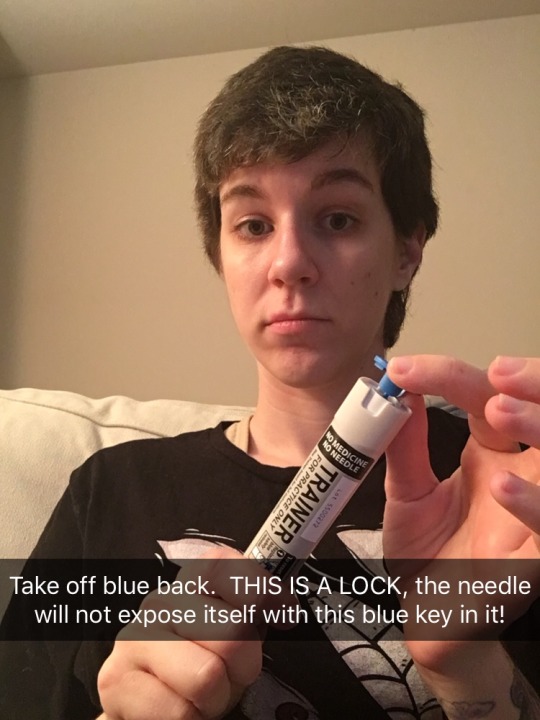
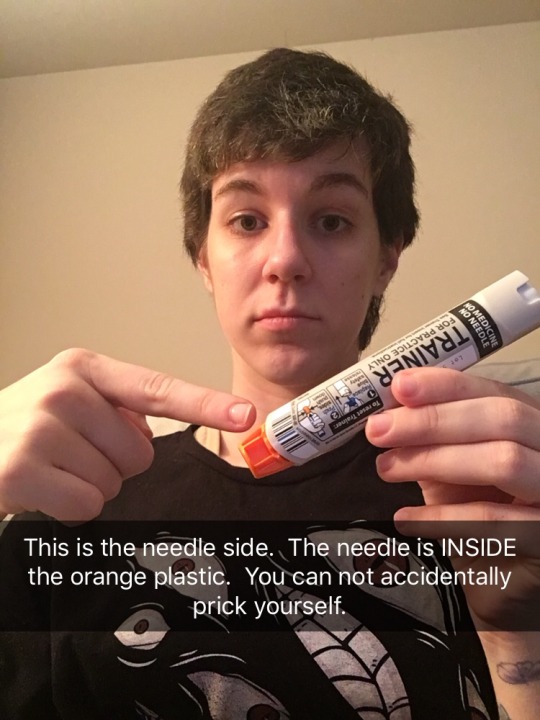
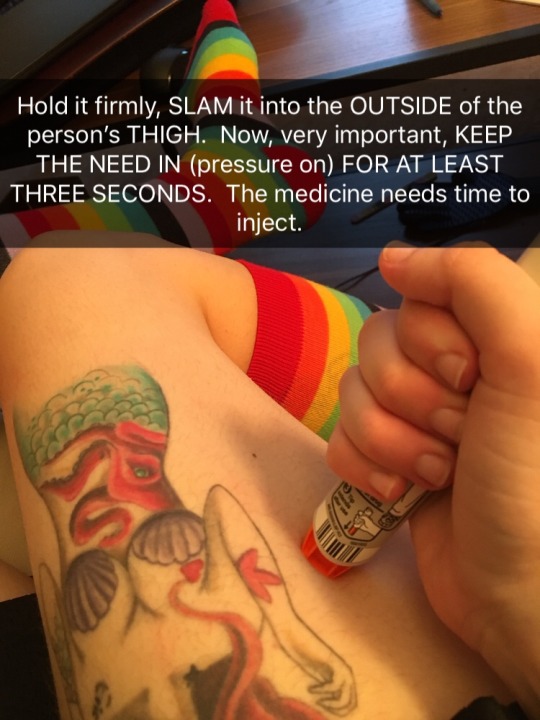

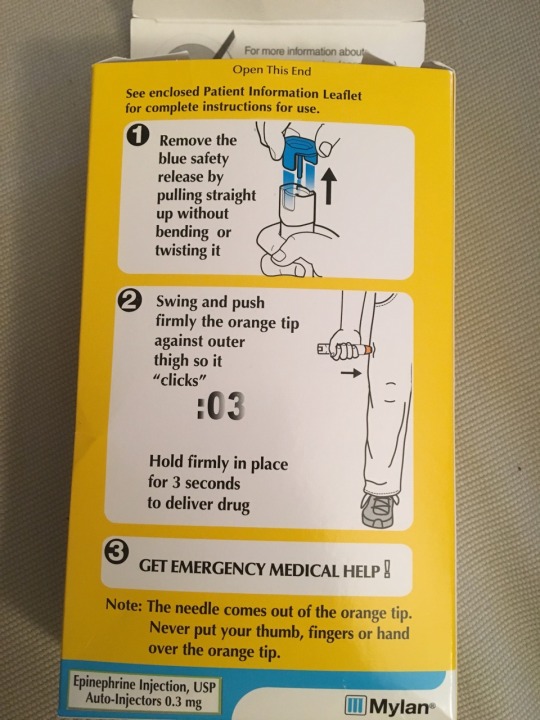
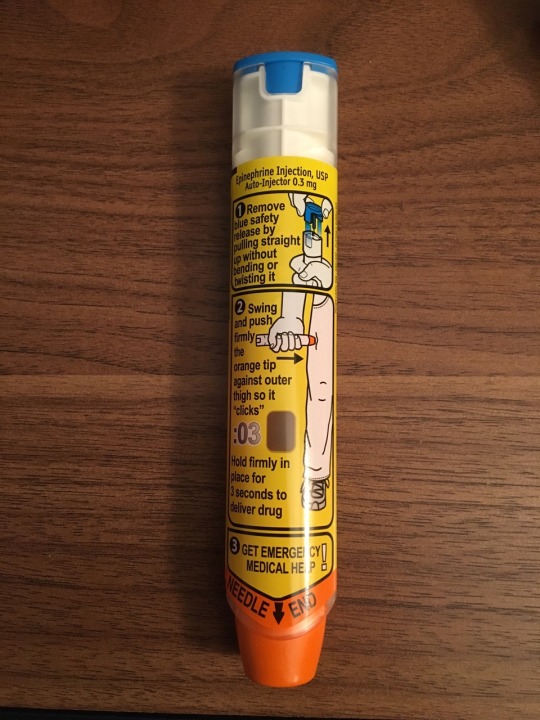
(Real pen the last picture)
It is important for EVERYONE to know how to help ANYONE. Not everyone can give them selves their medicine under every circumstance. Be educated, help out.
In the last year, i have gotten about five new violent allergies from foods i used to be able to eat. Next time i eat a fruit, my throat could close. I may not be able to inject myself. My boyfriend and i played with my trainer pen for like 30 minutes. He knows how to inject it. I know how. This is important.
#described#feel free to say how I can improve the description I feel like it’s not the best sorry#allergy#epipen#disability#resources#signal boost#important
238K notes
·
View notes
Text
Urgent Care for Allergies in Fresno: What Treatments Are Available?

When allergy symptoms strike suddenly or severely in Fresno, knowing where to turn for quick relief is crucial. While primary care physicians are excellent for long-term allergy management, urgent care for allergies in Fresno offers immediate solutions for acute symptoms, helping you find comfort faster. Our clinics are equipped to assess your symptoms and provide targeted treatments, getting you back to feeling better without the long wait times often associated with emergency rooms.
Common Treatments Offered
Upon arrival, our healthcare professionals will evaluate your symptoms, which may include sneezing, a runny nose, itchy eyes, skin rashes, or mild breathing difficulties. Based on your assessment, various treatments are available:
Oral Antihistamines: These are often the first line of defense to block histamine, the chemical responsible for most allergy symptoms. We can prescribe stronger, non-drowsy options than what's available over-the-counter.
Nasal Sprays: Corticosteroid nasal sprays can effectively reduce nasal inflammation and congestion. Decongestant nasal sprays might be used for short-term relief of stuffiness.
Eye Drops: For itchy, watery, or red eyes, medicated eye drops can provide quick relief by reducing inflammation and irritation.
Corticosteroids (Oral or Injected): For more severe allergic reactions, such as widespread rashes or significant inflammation, a short course of oral corticosteroids or an injection can rapidly reduce swelling and suppress the immune response.
Epinephrine Auto-Injector Prescription: If you're experiencing a severe allergic reaction (anaphylaxis) or are at risk, urgent care can administer epinephrine and provide a prescription for an auto-injector (like an EpiPen) for future emergencies, along with clear instructions on its use.
Nebulizer Treatments: For mild to moderate asthma-like symptoms triggered by allergies, nebulizer treatments can deliver bronchodilators to open airways and ease breathing.
Topical Creams: For allergic skin reactions like hives or eczema, topical corticosteroid creams can alleviate itching and inflammation.
While urgent care can manage acute allergy symptoms, we also emphasize the importance of follow-up with your primary care physician or an allergist for comprehensive, long-term allergy management, including identifying specific triggers and exploring allergy testing or immunotherapy options.
#hospital#urgent care near me fresno#walk-in clinic fresno#urgent care fresno#doctors#emergencycare#affordable urgent care
0 notes
Text
Allergy Relief for Kids: Exploring Treatment Options with a McKinney Allergist

Hi, I’m Isabella Brown—a pediatric care blogger and a parent who truly understands just how tough allergies can be on kids. Here in McKinney, Texas, our children face unique challenges when it comes to allergies. If your child is sniffling, itching, or struggling to keep up during outdoor play, you’re not alone—and there’s plenty of support right here in our community.
Understanding Childhood Allergies in McKinney
Allergies are among the most common chronic conditions in children. The Centers for Disease Control and Prevention report that almost 1 in 5 kids in the U.S. has an allergy—whether to pollen, food, pets, or other everyday triggers (CDC Data Brief). In places like McKinney, our seasonal weather, plant life, and even indoor environments can make symptoms worse.
Common Symptoms Worth Watching
Every child’s allergy symptoms can look a little different, but the most frequent signs include:
Sneezing, runny or stuffy nose
Itchy, watery eyes
Skin rashes or eczema
Coughing or wheezing
Tummy troubles after eating certain foods
If your child often feels sick during spring or fall, wakes up congested, or develops mysterious rashes, allergies might be playing a part.
The Role of a McKinney Allergist
If you suspect allergies, consulting with a pediatric “allergist mckinney tx” can be a game-changer. Allergists are specially trained to pinpoint what’s causing your child’s symptoms and to craft a treatment plan that fits your family’s lifestyle.
Treatment Options for Lasting Relief
Let’s break down the most effective ways to manage and treat childhood allergies:
1. Allergen Avoidance
The first line of defense is often to minimize your child’s exposure to known triggers:
Track local pollen forecasts and encourage indoor play when counts are high.
Use air purifiers and change HVAC filters regularly.
Wash hands and faces, and change clothes after time outdoors.
2. Medication
If symptoms persist, your allergist may suggest:
Antihistamines for quick relief of sneezing and itchy eyes.
Nasal steroids to reduce inflammation in the nose.
Leukotriene modifiers for asthma or nasal allergy symptoms.
Most of today’s allergy medicines are safe for children and can drastically improve quality of life.
3. Immunotherapy (Allergy Shots or Drops)
Immunotherapy works by gradually exposing your child’s immune system to small amounts of allergens, which can actually reduce or eliminate allergic reactions over time. This long-term solution can be especially effective for severe pollen, dust mite, or pet allergies.
4. Emergency Management
For children with food allergies or asthma, having an action plan—and making sure caregivers know what to do in an emergency—is essential. Sometimes an epinephrine auto-injector is needed for serious reactions.
Supporting Your Child
Empower your child to recognize their symptoms, participate in their treatment, and communicate with teachers and friends about allergies. A knowledgeable, supportive family makes all the difference.
Final Thoughts
Working with a local McKinney allergist, staying informed, and following proven strategies can help your child move from merely coping to truly thriving—even during allergy season.
References:
CDC Data Brief on Diagnosed Allergic Conditions in Children
American College of Allergy, Asthma & Immunology - Kids and Allergies
American Academy of Pediatrics - Allergy Tips on HealthyChildren.org
Asthma and Allergy Foundation of America - Allergy Treatment
1 note
·
View note